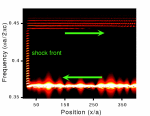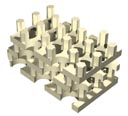
|
|
|
|
|
|
|
|
|
|
|
|
Photonic Crystal Research
About half of our group is dedicated to working on problems related to a new kind of material, photonic crystals (also known as photonic band-gap materials). Photonic crystals are periodic dielectric structures that have a band gap that forbids propagation of a certain frequency range of light. This property enables one to control light with amazing facility and produce effects that are impossible with conventional optics.
Photonic crystals are described exactly by Maxwell's Equations, which we can (and do) solve by the application of massive computational power. Much of our research, however, is directed at achieving a higher level of understanding of these systems, so that we can predict and explain their behavior without resorting to brute force calculation.
We are also interested in finding new phenomena and devices that are made possible by photonic crystals, and have already filed several patents for our discoveries.
Our group works closely with researchers in the Materials Science and Engineering department of MIT (CMSE) and elsewhere to actually fabricate our designs.
Tutorials and Software
 Photonic Crystals: Molding the
Flow of Light: The greatly revised second edition of our
popular textbook on photonic crystals is now available, including a
PDF of the entire book readable online at no cost.
Photonic Crystals: Molding the
Flow of Light: The greatly revised second edition of our
popular textbook on photonic crystals is now available, including a
PDF of the entire book readable online at no cost.
 Photonic
Crystals Tutorial: We have placed online the slides and other
materials from various tutorials on photonic crystals and related
subjects. This course introduced light propagation in periodic
systems, photonic crystals and band gaps, localized defect states, 3d
fabrication technology, hybrid structures and index guiding, and
photonic-crystal fibers, among other topics.
Photonic
Crystals Tutorial: We have placed online the slides and other
materials from various tutorials on photonic crystals and related
subjects. This course introduced light propagation in periodic
systems, photonic crystals and band gaps, localized defect states, 3d
fabrication technology, hybrid structures and index guiding, and
photonic-crystal fibers, among other topics.
![]() MIT
Photonic-Bands: MPB is a free program to compute the band
structures (dispersion relations) and electromagnetic modes of
periodic dielectric structures; it is designed for studying the
photonic-crystal systems that are the focus of our research. MPB's
features include: fully-vectorial, 3D computations; a flexible user
interface based upon the GNU Guile scripting language; output in HDF
format; and iterative, "targeted" eigensolver methods to address very
large problems by solving for only a few states near a specified
frequency. It is portable to most Unix-like systems, and parallel
support is forthcoming.
MIT
Photonic-Bands: MPB is a free program to compute the band
structures (dispersion relations) and electromagnetic modes of
periodic dielectric structures; it is designed for studying the
photonic-crystal systems that are the focus of our research. MPB's
features include: fully-vectorial, 3D computations; a flexible user
interface based upon the GNU Guile scripting language; output in HDF
format; and iterative, "targeted" eigensolver methods to address very
large problems by solving for only a few states near a specified
frequency. It is portable to most Unix-like systems, and parallel
support is forthcoming.
Research Projects and Results
 The Color of
Shock Waves in Photonic Crystals: New physical effects occur when
light interacts with a shock wave propagating through a one-dimensional
photonic crystal. These new phenomena include frequency shifts across the
photonic crystal bandgap and the bandwidth narrowing of an arbitrary input
signal with 100% efficiency. Light can also be slowed down by orders of
magnitude.
The Color of
Shock Waves in Photonic Crystals: New physical effects occur when
light interacts with a shock wave propagating through a one-dimensional
photonic crystal. These new phenomena include frequency shifts across the
photonic crystal bandgap and the bandwidth narrowing of an arbitrary input
signal with 100% efficiency. Light can also be slowed down by orders of
magnitude.
 Resonant Cavities: By making point defects in a photonic crystal, light can be localized, trapped in the defect. The frequency, symmetry, and other properties of the defect mode can be easily tuned to anything desired.
Resonant Cavities: By making point defects in a photonic crystal, light can be localized, trapped in the defect. The frequency, symmetry, and other properties of the defect mode can be easily tuned to anything desired.
 One-dimensionally
Periodic Structures: By adding a periodic structure to a
conventional waveguide, it is possible to create a one-dimensionally periodic
photonic crystal. Such structures can be used as high-Q filters, and
have been successfully fabricated and tested by our colleagues in
CSME.
One-dimensionally
Periodic Structures: By adding a periodic structure to a
conventional waveguide, it is possible to create a one-dimensionally periodic
photonic crystal. Such structures can be used as high-Q filters, and
have been successfully fabricated and tested by our colleagues in
CSME.

 Three-dimensional
Structures: We have proposed (in 1994 and 2000) structures
with full three-dimensional band gaps which, we hope, will be amenable
to fabrication.
Three-dimensional
Structures: We have proposed (in 1994 and 2000) structures
with full three-dimensional band gaps which, we hope, will be amenable
to fabrication.
 Waveguide Bends: With photonic crystals, it is possible to create waveguides that permit 90 degree bends with 100% transmission. This phenomenon can be understood as the analogue of one-dimensional resonant tunnelling phenomena in quantum mechanics.
Waveguide Bends: With photonic crystals, it is possible to create waveguides that permit 90 degree bends with 100% transmission. This phenomenon can be understood as the analogue of one-dimensional resonant tunnelling phenomena in quantum mechanics.
 Channel-Drop Filters: Photonic
crystals can be used to design a perfect channel-drop filter. This is
a device which picks out a small range of frequencies from a waveguide
and reroutes it in another direction, leaving the other frequencies
unaffected.
Channel-Drop Filters: Photonic
crystals can be used to design a perfect channel-drop filter. This is
a device which picks out a small range of frequencies from a waveguide
and reroutes it in another direction, leaving the other frequencies
unaffected.
 Waveguide Crossings: We have proposed a
novel design for intersecting optical waveguides with negligible
crosstalk, using general symmetry considerations that can be applied
a priori to diverse systems.
Waveguide Crossings: We have proposed a
novel design for intersecting optical waveguides with negligible
crosstalk, using general symmetry considerations that can be applied
a priori to diverse systems.
 Photonic Micropolis: This is not a
research project, but is simply a fanciful depiction of a "photonic
micropolis" incorporating many elements of our research. Photonic
crystal buildings house bundles of light, and highways and bridges
guide light along narrow channels and around tight corners.
Photonic Micropolis: This is not a
research project, but is simply a fanciful depiction of a "photonic
micropolis" incorporating many elements of our research. Photonic
crystal buildings house bundles of light, and highways and bridges
guide light along narrow channels and around tight corners.